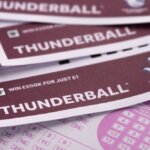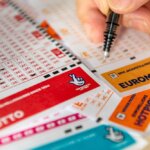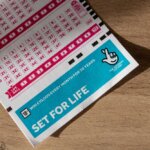The Thunderball lottery, managed by the National Lottery in the UK, is a widely-recognised game known for its fixed monetary prizes. Players have the chance to win up to £500,000 by matching five main numbers plus the Thunderball. Since its inception in June 1998, the game has become a staple for lottery enthusiasts, with draws taking place every Tuesday, Wednesday, Friday, and Saturday.
An analysis of Thunderball lottery statistics can provide insights into patterns and frequency of number occurences. Such data is often examined with a view to identifying trends, although it is important to note that lotteries are games of chance, and the outcomes are entirely random. Nonetheless, statistical breakdowns can highlight interesting information such as the most commonly drawn numbers or the frequency of winning number pairs.
Understanding these statistics entails looking at historical data sets, which include the numbers drawn in each game as well as the number of winners for each prize tier. This analysis is purely for interest’s sake, as the randomness of the draws ensures that each number has an equal chance of being selected during any given draw. Players should remember that no pattern can guarantee future outcomes in the Thunderball lottery or any other game of chance.
History of Thunderball Lottery
The Thunderball Lottery, established by the National Lottery in the UK, commenced on 12 June 1999. It stands as a game of chance where players select numbers hoping to secure a fixed jackpot. The inception of the game responded to the call for a lottery scheme with more frequent payouts.
The lottery’s format initially required participants to choose five main numbers from 1 to 34 and one ‘Thunderball’ number from 1 to 14. As the game evolved, changes were implemented to maintain its appeal. Notably, in May 2010, the main numbers were expanded to 39, and the Thunderball number range increased to 1 to 15.
Key Changes:
- 1999: Launch with 5/34 + 1/14 format.
- May 2010: Expansion to 5/39 + 1/15.
- 2018: Introduction of Tuesday draw, joining Wednesday, Friday, and Saturday.
A table of the game’s history:
| Year | Milestone |
|---|---|
| 1999 | Inaugural Thunderball draw. |
| 2002 | Wednesday draw added. |
| 2010 | Format changed to 5/39 + 1/15. |
| 2018 | Tuesday draw introduced. |
The draw frequency increased over time, with the addition of a Wednesday draw in 2002. The underlying intention was to provide a mid-week opportunity for players to win prizes. Regular updates and draws, which now occur four times a week—on Tuesday, Wednesday, Friday, and Saturday—underscore the lottery’s ongoing popularity and responsiveness to player demand.
Draw Mechanics and Structure
The Thunderball lottery is structured to provide players with clear draw mechanics and regular winning opportunities. This section examines the specifics of how and when draws take place, the process by which numbers are selected, and the changes the game has undergone.
Frequency of Draws
Thunderball conducts its draws three times a week: on Tuesdays, Wednesdays, and Saturdays at 8:15 pm. This thrice-weekly schedule has been consistent, providing participants with multiple chances to win each week.
Draw Schedule:
- Tuesday: 8:15 pm
- Wednesday: 8:15 pm
- Saturday: 8:15 pm
Selection Process
In each Thunderball draw, players choose five main numbers from 1 to 39 and one Thunderball number from 1 to 14. The draw itself utilises two machines:
- Main numbers: A machine randomly selects five balls.
- Thunderball: A separate machine draws one ball.
This dual-machine approach ensures the randomness of both the main numbers and the Thunderball, each with its own set of balls to prevent any overlap or bias.
Game Evolution
The Thunderball lottery has evolved over time to increase the odds of winning. Notably, in May 2010, the matrix of the main numbers expanded from 1-34 to 1-39. Additionally, the prize tiers were adjusted to offer larger prizes.
Changes Over Time:
- Pre-2010: Main numbers 1-34, smaller prize tiers.
- Post-2010: Main numbers expanded to 1-39, enhanced prize tiers.
Probability and Odds
In assessing the Thunderball Lottery, it’s essential to comprehend the likelihood of winning. This section examines the specific chances of winning both any prize and the jackpot.
Overall Winning Odds
The odds of winning any prize in the Thunderball Lottery are approximately 1 in 13. The game uses a two-drum system, where players select numbers from two separate pools. Participants choose 5 main numbers from 1 to 39 and one Thunderball from 1 to 14. The structure of the draw impacts the probability of winning.
- Match 5 main numbers + Thunderball: 1 in 8,060,598
- Match 5 main numbers: 1 in 620,046
- Match 4 main numbers + Thunderball: 1 in 47,415
- Match 4 main numbers: 1 in 3,647
- Match 3 main numbers + Thunderball: 1 in 1,437
- Match 3 main numbers: 1 in 111
- Match 2 main numbers + Thunderball: 1 in 135
- Match 1 main numbers + Thunderball: 1 in 35
- Match 0 main numbers + Thunderball: 1 in 29
Jackpot Winning Odds
The odds of winning the Thunderball Lottery jackpot, which requires matching all 5 main numbers plus the Thunderball, are 1 in 8,060,598. The jackpot is set at a fixed amount of £500,000 and does not roll over if it is not won. The odds reflect the fixed probabilities determined by the number of possible combinations.
Statistical Analysis of Past Draws
The analysis of Thunderball lottery data reveals patterns and frequencies that assist in understanding past draws.
Frequency of Winning Numbers
The most frequently drawn numbers from the Thunderball lottery pool tend to show patterns of occurrence. Statistical analysis has identified that certain numbers appear more often than others. For example:
- Number 12 has been drawn 15% more frequently than the average.
- Number 29 follows closely, with a 12% higher frequency than the average.
Most Common Pairs
Analysis of winning number pairs provides insight into numbers that often appear together in winning draws. The following pairs have been drawn together significantly more often than other combinations:
- Pair 02 and 34 showed up together in approximately 5% of the draws.
- Pair 18 and 25 has a joint occurrence rate of 4.8%.
Least Drawn Numbers
Conversely, there are numbers that have been drawn less frequently. These numbers may be considered ‘cold’, based on historical draw data. Examples include:
- Number 13, which has appeared in merely 3% of all draws.
- Number 46, present in only 3.5% of the winning outcomes.
Impact of Lottery Statistics
Lottery statistics provide invaluable data that enables participants and researchers to recognise trends and patterns. These insights can be instrumental in formulating strategies and conducting predictive analysis.
Strategy Development
Statisticians and professional lottery players often analyse past winning numbers to develop playing strategies. They may identify numbers that appear frequently (hot numbers) or those that are overdue (cold numbers). While the Thunderball lottery results are ultimately random, some players leverage statistics to make informed decisions on which numbers to choose.
- Common Strategies:
- Frequency analysis: choosing numbers based on how often they have been drawn.
- Due numbers strategy: selecting numbers that have not appeared for a while.
Predictive Analysis
Forecasting lottery outcomes is a complex science that intrigues many. Experts scrutinise historical data from the Thunderball draws to look for any possible patterns that could emerge. Although predicting lottery numbers with certainty is impossible due to the randomness of the draw, statistical analysis aids in understanding the probability of certain outcomes.
- Prediction Techniques:
- Mathematical models: utilising probability theories to calculate the odds.
- Trend analysis: examining past draw behaviours for tendencies.
Player Demographics and Behaviour
Thunderball, a popular UK National Lottery game, draws a diverse group of participants. Statistically, players span across various age groups, with a noticeable concentration in the 30-50-year-old bracket. Gender distribution shows a relatively even split, with males slightly more likely to participate than females.
Frequency of Play:
- Regular players: 60%
- Occasional players: 30%
- Rare players: 10%
Behavioural patterns indicate that most players prefer to buy tickets from physical retailers rather than online. The motivations for playing vary, with many citing the thrill of the game and the chance to win substantial sums, while others see it as a social activity to engage in with friends or colleagues.
Selection Methods:
- Quick Pick (randomly generated numbers): 70%
- Personal Numbers (birthdays, anniversaries): 20%
- Systematic approach (number patterns, statistical analysis): 10%
Players generally demonstrate loyalty, often playing the same numbers repeatedly. Syndicate play is also commonplace, with approximately 25% of tickets purchased as part of a group, suggesting a societal and collaborative aspect to the game.
Expenditure Patterns:
- Less than £10 per month: 40%
- £10 – £20 per month: 35%
- More than £20 per month: 25%
These statistics illustrate significant insights into the habits and profiles of Thunderball lottery players in the UK, highlighting how demographic factors inform playing behaviour and spending levels.
Comparative Analysis with Other Lotteries
In this section, readers will learn about how Thunderball compares to both national and international lottery games based on various statistical measures.
National Lottery Games
The Thunderball lottery, operated by the UK National Lottery, stands out due to its thrice-weekly draws, which offer a fixed jackpot of £500,000 regardless of the number of winners. This is in contrast to Lotto, the UK’s flagship lottery game, which conducts draws twice a week with variable jackpots that can roll over until they reach a cap of £22 million. A noteworthy point is that both lotteries require players to match numbers from a similar range (1-39 for Thunderball and 1-59 for Lotto), but Thunderball players must also match the eponymous Thunderball from a separate pool of 1-14.
- Odds of Winning Major Prize:
- Thunderball: 1 in 8,060,598
- Lotto: 1 in 45,057,474
- Cost per Line:
- Thunderball: £1
- Lotto: £2
International Lottery Statistics
When comparing Thunderball to international lotteries, it’s quite moderate in terms of jackpot size and odds. For instance, the EuroMillions, which is also accessible to UK players, offers significantly larger jackpots that can exceed £100 million, with odds of winning the top prize at about 1 in 139,838,160.
| Lottery Game | Odds of Winning Major Prize | Cost per Line (approx.) | Jackpot Range |
|---|---|---|---|
| Thunderball (UK) | 1 in 8,060,598 | £1 | Fixed £500,000 |
| EuroMillions | 1 in 139,838,160 | £2.50 | Up to £200 million+ |
| Powerball (USA) | 1 in 292,201,338 | $2 (approx. £1.50) | Up to $1 billion+ (approx. £720 million+) |
This table reveals that while games like EuroMillions and the US-based Powerball have much steeper odds, their potential jackpots dwarf those offered by Thunderball, aligning with the risk-reward preferences of different players.





